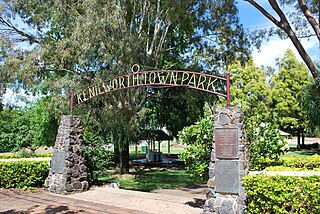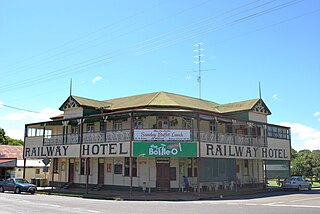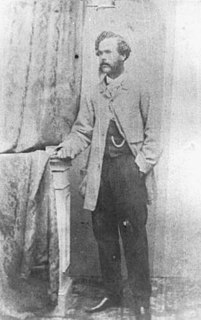
Gympie is a city and a locality in the Gympie Region, Queensland, Australia. In the Wide Bay-Burnett District, Gympie is about 170.7 kilometres (110 mi) north of the state capital, Brisbane. The city lies on the Mary River, which floods Gympie occasionally. Gympie is the administrative centre for the Gympie Region area. As of June 2018 Gympie had a population of 51,578.

Kenilworth is a small town and locality in the heart of the Mary Valley area of the Sunshine Coast, Queensland, Australia. This is a rural area, about 50 kilometres (31 mi) from the coast, with dairy farming as the major industry. Local visitor attractions include a cheese factory as well as walking, camping and 4-wheel driving in the Kenilworth State Forest.

Kandanga is a town and a locality in the Gympie Region, Queensland, Australia. In the 2016 census, Kandanga had a population of 665 people.

Kilkivan is a town and locality in the Gympie Region of Queensland, Australia. At the 2016 census, Kilkivan had a population of 713. Rossmore is a neighbourhood within the locality to the south-west of the town of Kilkivan.

The Shire of Kilkivan was a local government area about 180 kilometres (112 mi) north-northwest of Brisbane, the state capital of Queensland, Australia. The shire covered an area of 3,263.4 square kilometres (1,260.0 sq mi), and existed from 1886 until its merger with several other local government areas to form the Gympie Region on 15 March 2008.

Coes Creek is a rural locality in the Sunshine Coast Region, Queensland, Australia. In the 2016 census, Coes Creek had a population of 1,392 people.

Lawnton is a suburb in the Moreton Bay Region, Queensland, Australia.

Barambah is a rural locality in the Gympie Region, Queensland, Australia. In the 2016 census Barambah had a population of 46 people.

The Gympie Times is a daily newspaper serving Gympie in Queensland, Australia. The newspaper is owned by News Corp Australia and is published from Monday to Saturday.

Imbil is a rural town and locality in the Gympie Region, Queensland, Australia. In the 2016 census, Imbil had a population of 924 people.

Amamoor is a rural town and locality in the Gympie Region, Queensland, Australia. In the 2016 census the locality of Amamoor had a population of 636 people.

Hugo William Du Rietz was a pioneer gold miner and architect in Gympie, Queensland, Australia. He was the architect of many heritage-listed buildings in Gympie.

John O'Connell Bligh was a Native Police officer in the British colonies of New South Wales and Queensland. He achieved the rank of Commandant of this colonial paramilitary force from 1861 to 1864. Bligh is probably best known for an incident in Maryborough, where he shot a number of Aboriginal Australians along the main street and into the adjoining Mary River. After retiring from the Native Police, Bligh became a police magistrate in the towns of Gayndah and Gympie.

Wolvi is a rural locality in the Gympie Region, Queensland, Australia. In the 2016 census, Wolvi had a population of 467 people.

Mondure is a rural town and locality in the South Burnett Region, Queensland, Australia. In the 2016 census, Mondure had a population of 100 people.

Wilsons Pocket is a rural locality in the Gympie Region, Queensland, Australia. In the 2016 census Wilsons Pocket had a population of 197 people.

Cooroy Post Office is a heritage-listed post office at 33 Maple Street, Cooroy, Shire of Noosa, Queensland, Australia. It was designed by Thomas Pye and built in 1914 by L. Baldry. It was added to the Australian Commonwealth Heritage List on 22 August 2012.

Goomeribong is a locality in the Gympie Region, Queensland, Australia. In the 2016 census, Goomeribong had a population of 41 people.

Heber Hedley Booth was a Queensland-based Australian poet who wrote under the nom de plume Opal, known principally for his inaugural anthology Opalodes (1909). His poems made much reference to the locations of northern Australia, although several involved political comment of actions at the time. Booth's writings covered the early Federation of Australia from a Queensland perspective, possibly influenced by the earlier 1890s Central Queensland Territorial Separation League and the ongoing North Queensland separation movements.















